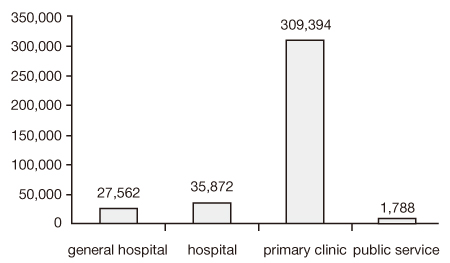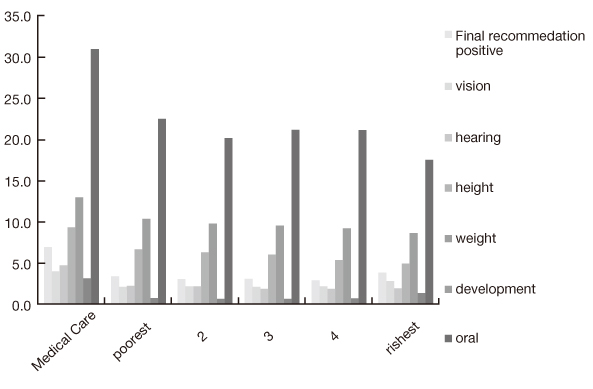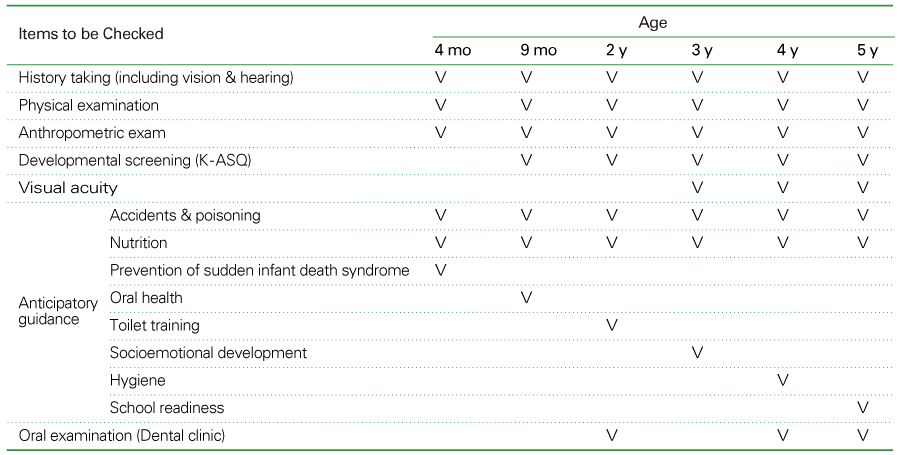 |
 |
- Search
| J Korean Med Assoc > Volume 53(5); 2010 > Article |
Abstract
National health screening program for infants and children in Korea was launched in November 2007 to cope with current health issues, such as high prevalence of accidents and incremental trends of developmental disorders and obesity. It is a kind of population surveillance systems which contains history taking, physical examination, anthropometric measurements, screening for visual acuity and questionnaires with anticipatory guidance. This program has been successfully implanted as one of the primary clinical services. First year's rate of participation was 35.3%. For the next few years, participation rate should be improved and quality control may be needed especially about counseling with the anticipatory guidance. Sociocultural changes and legislation should be tried to encourage double-income couples to bring their children for this periodic examination. Abnormal results were relatively high in the babies with the history of prematurity and low economical status. Thus, these groups could be the targets of the public health supports. To meet the future computerization of the health screening system, it is needed to develop the Korean developmental screening tools to replace K-ASQ (Korean Ages & Stages Questionnaires), which is currently under foreign copyright. Regular revision of the protocols and questionnaires are also important to maintain this screening system as evidence-based.
References
1. Analysis about the factors affecting social changes for the next 10 years. Statistics Korea 2009;Available at http://www.kostat.go.kr/
2. Kim T, Lee I, Keum J, Park Y, Park H. Critical appraisal of governmental policy for the control of low birth rate 2007;Seoul: National Assembly Budget Office (Korea). 5-155.
3. Blair M, Stewart-Brown S, Waterston T, Crowther R. Child public health 2010;2nd ed. Oxford: Oxford University Press. 1-45.
4. Eun BL, Moon JS, Eun SH, Lee HK, Shin SM, Sung IK, Chung HJ. The current child and adolescent health screening system: an assessment and proposal for an early and periodic check-up program. Korean J Pediatr 2010;53:300-306.
5. Hall D, Williams J, Elliman D. The child surveillance handbook 2009;3rd ed. Abingdon: Radcliffe Publishing Ltd. 176-199.
6. Kim SW, Kim YK, Chung HJ. Well baby clinic: developmental guidance according to the parent's chief complaints. J Korean Med Assoc 2009;52:244-261.
7. Lee CG, Son CS, Hong YJ, Choi JM, Kim BI, Moon JS, Kim NH. A basic study on a survey of long-term variation trends and a plan for constructing observation system of hospitalized diseases to infants, children and adolescents. Final report 2007;Seoul: Ministry of Health and Welfare (Korea).
8. Oh K, Jang MJ, Lee NY, Moon JS, Lee CG, Yoo MH, Kim YT. Prevalence and trends in obesity among Korean children and adolescents in 1997 and 2005. Korean J Pediatr 2008;51:950-955.
9. McGill HC, McMahan CA, Gidding SS. Are pediatricians responsible for prevention of adult cardiovascular disease? Nat Clin Pract Cardiovasc Med 2009;6:10-11.
10. Eun BL, Chung HJ. Overview of the National Health Screening Program for Infant and Children. J Korean Med Assoc 2008;51:74-83.
11. Shin SM, Chung HJ, Sung IK, Lee HK, Shin HJ, Moon JS, Jeong SJ, Jin BH, Lim HT, Park SK. Revision of doctor's manual for the health promotion program of infant & children and development of additional teaching material for the parents. Final report 2009;Seoul: Ministry of Health and Welfare (Korea).
12. U.S. Preventive Services Task Force. The guide to clinical preventive services: recommendations of the U.S. Preventive Services Tack Force. AHRQ publication 2006;Washington, D.C.: Agency for Healthcare Research and Quality. 1-212.
13. In: Hagan JF, Shaw JS, Duncan PM, editor. Bright Futures: guidelines for health supervision of infants, children, and adolescents 2008;Elk Grove Village, IL: American Academy of Pediatrics.
14. Moon JS, Lee SY, Nam CM, Choi JM, Choe BK, Seo JW, Oh K, Jang MJ, Hwang SS, Yoo MH, Kim YT. 2007 Korean National Growth Charts: review of developmental process and an outlook. Korean J Pediatr 2008;51:1-25.
15. Moon JS, Kim JY, Chang SH, Choi KH, Yang HR, Seo JK, Ko JS, Choi KD, Seo JW, Chung HJ, Eun BL, Hwang SS, Seo SR, Kim HS. Development of nutrition questionnaire and guideline in the Korea national health screening program for infants and children. Korean J Pediatr Gastroenterol Nutr 2008;11:42-55.
16. Yi JS, Cho KS. Review about developmental screening and assessment tests for young children in Korea. J Spec Educ:Theory Pract 2004;5:1-26.
17. Moon JS, Lee SY, Eun BL, Kim YK, Kim SW, Shin SM, Lee HK, Chung HJ. One-year evaluation of the national health screening program for infants and children in Korea. Korean J Pediatr 2010;53:307-313.
18. UK Screening Portal. UK National Screening Committee Accessed at 25 Apr, 2010. Available at http://www.screening.nhs.uk/
19. The Report of the dietary guidelines advisory committee on dietary guidelines for Americans. Dietary Guidelines Advisory Committee 2005;Accessed at 25 Apr, 2010. Washington, D.C.: USDA. Available at http://www.health.gov/dietaryguidelines/dga2005/report/
20. Chung HJ, Eun BL, Kim SW, Kim YK, Moon JS, Shin SM, Lee SY, Lee HK. Short-term Effects of Health Promotion Program of Infant & Children in Korea: An analysis. Final report 2009;Seoul: Ministry of Health and Welfare(Korea).
Figure 1
Most of the participants, who joined National Health Screening Program for Infants and Children in Korea, used the primary clinics.

Figure 2
Positive rates of recommendation for the further evaluation and positive rates of other screening components in National Health Screening Program for Infants and Children showed incremental trends in lower income classes. Quintile distribution according to the income, which was based on National Health Insurance Cooperation data, was used. This figure was adapted from the reference 17.

Figure 3
Positive rates of recommendation for the further evaluation in National Health Screening Program for Infants and Children showed higher prevalence in babies with preterm history than full-term. Data of National Health Insurance Cooperation was used. This figure was adapted from the reference 20.

Table 2
Positive rates in National Health Screening Program for Infants and Children in Korea (2008)

*Growth data was evaluated by 2007 Korean National Growth Charts.
†based on the data from Heath Screening Results Form
‡Applied only in 18 and 60 months
This table was adapted from the reference 17.
- TOOLS
-
METRICS

-
Related articles in
J Korean Med Assoc -
Recommended Immunization Schedule for Health Infants and Children1997 December;40(12)
Proposal of a Screening Program for Gastric Cancer in Korea2002 August;45(8)
Lifetime Health Maintenance Program for Koreans2003 November;46(11)
Overview of the National Health Screening Program for Infant and Children2008 January;51(1)






